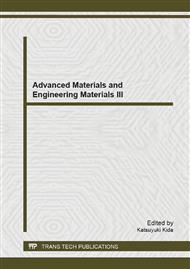[1]
L. Aihua, D. Jianxin, C. Haibing, C. Yangyang, and Z. Jun, Friction and wear properties of TiN, TiAlN, AlTiN and CrAlN PVD nitride coatings, Int. Journal of Refractory Metals and Hard Materials 31 (2012) 82–88.
DOI: 10.1016/j.ijrmhm.2011.09.010
Google Scholar
[2]
M. Godet, Y. Berthier, L. Vincent, L. Flamand, Hard Coating for Tribological Applications: a Pluridisciplinary Approach, Surface and Coatings Technology 45 (1991) 1-8.
DOI: 10.1016/0257-8972(91)90199-7
Google Scholar
[3]
D.M. Mattox , Handbook of physical deposition (PVD) processing, New Jersey, (1998).
Google Scholar
[4]
N. Panich, S. Surinphong, D.A. Karpov, Y. Kwang Tan, C.F. Goh, J. Ma, Mechanical Properties of AlCrTiSiN Coatings Developed by Cathodic Arc for Protection Applications, Solid State Phenomena Vol. 185 (2012) 81-83.
DOI: 10.4028/www.scientific.net/ssp.185.81
Google Scholar
[5]
H. Du, H. Zhao, J. Xiong, and G. Xian, Effect of interlayers on the structure and properties of TiAlN based coatings on WC-Co cemented carbide, Int. Journal of Refractory Metals and Hard Materials 37 (2013) 60 – 66.
DOI: 10.1016/j.ijrmhm.2012.10.017
Google Scholar
[6]
K.L. Johnson, Contact mechanics, Cambridge, (1985).
Google Scholar
[7]
Information on http: /www. meadinfo. org/2010/03/s45c-jis-mechanical-properties. html.
Google Scholar
[8]
T. Usana - ampaipong, S. Prapasuk, K. Feung – im, K. Tuchinda, K. Wathanyu, S. Surinphong and N. Panich, The Study of Interlayer Element Effect on the Properties of AlCrTiSiN Thin Film for Milling Process, Senior project, KMUTT, (2012).
DOI: 10.4028/www.scientific.net/amr.893.543
Google Scholar
[9]
H. Ezura, K. Ichijo, H. Hasegawa, K. Yamamoto, A. Hotta, and T. Suzuki, Micro-hardness, microstructures and thermal stability of (Ti, Cr, Al, Si)N films deposited by cathodic arc method, Vacuum 82 (2008) 476 – 481.
DOI: 10.1016/j.vacuum.2007.07.048
Google Scholar
[10]
K. Ichijo, H. Hasegawa, and T. Suzuki, Microstructures of (Ti, Cr, Al, Si)N films synthesized by cathodic arc method , Surface, Surface & Coatings Technology 201 (2007) 5477 – 5480.
DOI: 10.1016/j.surfcoat.2006.07.016
Google Scholar
[11]
T.V. Rajan, C.P. Sharma, and A. Sharma, Heat Treatment Principles and Techniques, fifteenth ed., Delhi, (2011).
Google Scholar
[12]
The American Ceramic Society, Progress in Nanotechnology Processing, New Jersey, (2010).
Google Scholar
[13]
D. Wu , J. Zhang, J.C. Huang, H. Bei, and T.G. Nieh, Grain-boundary strengthening in nanocrystalline chromium and the Hall–Petch coefficient of body-centered cubic metals, Scripta Materialia 68 (2013) 118 – 121.
DOI: 10.1016/j.scriptamat.2012.09.025
Google Scholar
[14]
Y. Xie and H.M. Hawthorne, A model for compressive coating stresses in the scratch adhesion test, Surface and Coatings Technology 141 (2001) 15 – 25.
DOI: 10.1016/s0257-8972(01)01130-6
Google Scholar
[15]
C.G. Morris, Academic Press Dictionary of Science and Technology, London, (1962).
Google Scholar
[16]
P. Hidnert, Thermal expansion of cemented tungsten carbide, Journal of Research of the National Bureau of Standards 18 (1937) 47 – 52.
DOI: 10.6028/jres.018.025
Google Scholar
[17]
Information on http: /periodictable. com/Properties/A/ThermalExpansion. an. html.
Google Scholar
[18]
M.F. Ashby and D.R.H. Jones , Engineering Materials 1, an Introduction to Their Properties & Applications, second ed., Cambridge, (1996).
Google Scholar
[19]
T.D. Nguyen, S.K. Kim, and D.B. Lee, High-temperature oxidation of nano-multilayered TiAlCrSiN thin films in air, Surface & Coatings Technology 204 (2009) 697 – 704.
DOI: 10.1016/j.surfcoat.2009.09.008
Google Scholar
[20]
E. Lassner and W. – D. Schubert, Tungsten Properties, Chemistry, Technology of the Element, Alloys, and Chemical Compounds, New York, (1999).
DOI: 10.1007/978-1-4615-4907-9
Google Scholar


